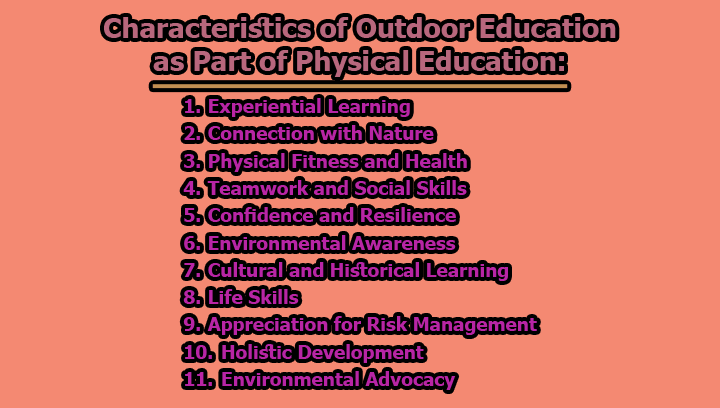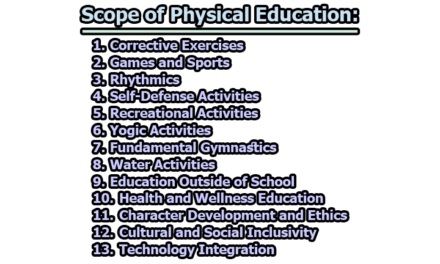Characteristics of Outdoor Education as Part of Physical Education:
Physical education is an integral part of a well-rounded education that promotes physical fitness, teamwork, and overall well-being. While traditional physical education classes often take place indoors, outdoor education offers a unique and enriching alternative. In this article, we will explore the characteristics of outdoor education as part of physical education.
1. Experiential Learning: Outdoor education is fundamentally grounded in experiential learning, a teaching approach that transcends the confines of traditional classroom settings. Instead of simply reading about ecosystems in a textbook, students are transported into the heart of nature, where they can engage directly with their surroundings. For instance, a trip to a nearby forest allows them to observe wildlife in its natural habitat, touch the bark of ancient trees, and inhale the scent of the earth. This immersive experience cultivates a profound connection to the subject matter, fostering a deeper level of understanding and engagement.
Experiential learning encourages students to actively participate in their own education. It transforms the passive process of absorbing information into an active pursuit of knowledge. By engaging all their senses, students are more likely to retain information and develop a lasting appreciation for the subject matter.
2. Connection with Nature: Spending time in the great outdoors is an opportunity for students to establish a profound and lasting connection with the natural world. Through direct experience, they come to understand the intricate web of life that surrounds them. Witnessing the changing seasons, from the vibrant colors of fall foliage to the rebirth of spring, instills a deep sense of awareness and connection.
Additionally, students have the chance to learn about local flora and fauna firsthand. They can identify native plants, track wildlife, and observe animal behavior patterns. This intimate knowledge goes beyond the acquisition of facts; it fosters a genuine sense of awe and respect for the environment.
This connection with nature often transcends the classroom and textbooks. It frequently evolves into a personal commitment to environmental stewardship and sustainability. Students who have experienced the beauty and vulnerability of the natural world are more likely to become advocates for its protection. They may take active roles in conservation efforts, participate in ecological research, or engage in initiatives to safeguard and restore natural environments.
3. Physical Fitness and Health: Outdoor education excels in promoting physical fitness and overall health. The activities undertaken in outdoor settings are not only enjoyable but also effective in improving physical well-being. Hiking through rugged terrain, biking along scenic trails, paddling down a meandering river, or engaging in team sports like soccer or frisbee all contribute to physical fitness in unique ways.
These activities provide opportunities for cardiovascular exercise, which enhances heart and lung health. They also engage various muscle groups, contributing to muscular strength and endurance. For example, hiking uphill or rock climbing requires substantial leg strength while paddling or kayaking builds upper body and core strength. Agility and balance are honed through activities such as trail running or navigating uneven terrain.
Beyond the physical benefits, the open-air environment of outdoor education has positive effects on respiratory health. Fresh, clean air provides optimal oxygenation for the body, which can lead to increased energy levels and improved mood. Exposure to natural sunlight during outdoor activities also has a positive impact on mental well-being, promoting the production of Vitamin D and helping to mitigate conditions like Seasonal Affective Disorder.
The cumulative effects of regular outdoor physical activity contribute to better overall health and well-being. In an era marked by sedentary lifestyles and the associated health risks, outdoor education serves as a potent antidote, encouraging students to embrace an active and healthy lifestyle.
4. Teamwork and Social Skills: One of the central strengths of outdoor education lies in its inherent promotion of teamwork and the development of essential social skills. Many outdoor activities are intrinsically collaborative, requiring students to work together to overcome challenges and achieve common goals.
For instance, consider a rock-climbing expedition. In this scenario, each participant plays a crucial role: one may belay, ensuring the climber’s safety, while others provide guidance and support. Effective communication is vital, as climbers need to convey their intentions and receive feedback from their team members.
Similarly, orienteering exercises often involve small groups navigating through unfamiliar terrain. In these situations, participants must communicate effectively to read maps, interpret compass readings, and coordinate their movements. If one team member misunderstands directions or fails to communicate clearly, the entire group may become disoriented.
Group challenges, which are common in outdoor education, compel students to collaborate and problem-solve. They learn how to leverage individual strengths and compensate for weaknesses within the team. This experiential learning fosters a broad spectrum of social skills, including effective communication, leadership, conflict resolution, and the ability to work harmoniously in a team.
Moreover, outdoor education often places students in unfamiliar and sometimes challenging situations, which can be emotionally charged. Overcoming these obstacles and enduring adverse conditions can lead to the development of resilience. This resilience, in turn, boosts self-confidence and self-efficacy as students recognize their capacity to overcome difficulties. They gain the confidence to tackle new challenges, both in the outdoors and in other aspects of life.
5. Confidence and Resilience: The outdoor challenges encountered in an outdoor education setting often extend beyond physical skills. They also test students’ mental fortitude and emotional resilience. Whether it’s facing a fear of heights during a rock-climbing expedition or enduring adverse weather conditions while camping, students are continually pushed outside their comfort zones.
These experiences cultivate confidence and resilience. Students learn that they are capable of surmounting obstacles that may have initially seemed insurmountable. The exhilaration of achieving these milestones, whether it’s reaching the summit of a challenging peak or completing a long-distance trek, boosts self-confidence and provides students with a tangible sense of accomplishment.
Moreover, the development of resilience is a powerful byproduct of outdoor education. Students learn to adapt to unexpected challenges, embrace discomfort, and find inner strength. They discover that they can endure challenging circumstances and come out stronger on the other side. These lessons in resilience are not limited to the outdoor setting; they have profound implications for personal growth and success in various life situations.
6. Environmental Awareness: Outdoor education programs are ideally positioned to impart valuable lessons in environmental awareness and sustainability. These programs typically incorporate teachings on environmental issues, conservation efforts, and the importance of sustainable practices.
Students gain an understanding of the fragility of ecosystems and the often detrimental impacts of human activities. Through hands-on experiences, they witness firsthand the interconnectedness of all living things and the delicate balance that sustains life on Earth. This experiential learning deepens their appreciation for the natural world and fosters a sense of responsibility for its preservation.
One of the core lessons of outdoor education is the recognition that our actions have consequences. Students learn how choices in areas like waste management, resource consumption, and energy use affect the environment. This newfound awareness can have a profound impact on their attitudes and behaviors. They become more conscious of their ecological footprint and are more likely to adopt sustainable practices in their daily lives.
Furthermore, outdoor education often incorporates elements of ecological restoration and conservation. Students may participate in activities such as trail maintenance, habitat restoration, or wildlife monitoring. These activities not only contribute to environmental preservation but also instill a sense of pride and responsibility for the places they explore.
In essence, outdoor education cultivates a sense of environmental stewardship, encouraging students to become advocates for the environment. They may take on active roles in conservation efforts, participate in ecological research, or join initiatives aimed at safeguarding and restoring natural environments. This commitment to environmental advocacy often extends well beyond the classroom and becomes a lifelong passion.
7. Cultural and Historical Learning: Outdoor education experiences are not limited to the physical aspects of nature; they also often integrate cultural and historical elements. These interdisciplinary approaches enrich students’ education by connecting physical activities with broader cultural and historical contexts.
Consider a trip to a national park. In addition to experiencing the natural beauty of the park, students may learn about the indigenous cultures that once inhabited the area. They may explore archaeological sites, discover ancient petroglyphs, or visit reconstructed villages to gain insight into the ways of life of indigenous peoples.
Furthermore, outdoor education programs often emphasize the historical significance of the natural areas students explore. For example, a visit to a Civil War battlefield or an exploration of a geological site can provide opportunities for historical learning. Students may gain a deeper understanding of the events that shaped their local or regional history, connecting the dots between the physical landscape and the people and events that left their mark on it.
This multidimensional approach to education fosters a more profound sense of connection to the places students explore. They not only appreciate the natural beauty of these areas but also gain a greater understanding of their cultural and historical significance. This enriched perspective encourages a more comprehensive and holistic view of the environment, connecting physical, cultural, and historical elements.
8. Life Skills: Beyond the acquisition of academic knowledge, outdoor education equips students with a broad array of practical life skills. These skills are not only valuable in outdoor settings but also in everyday life. Among the most important of these skills are navigation, wilderness survival, and first aid.
Navigation skills involve understanding and using tools such as maps, compasses, and GPS devices to determine one’s location and plot a course to a destination. In an outdoor context, these skills are vital for maintaining safety and preventing getting lost. However, they also teach students important life lessons in planning, problem-solving, and self-reliance. Navigational skills require the ability to think critically, make decisions, and adapt to changing circumstances.
Wilderness survival skills encompass a range of abilities necessary for surviving in remote or challenging environments. Students learn how to build shelter, find and purify water, start a fire, and forage for food. These skills not only provide a practical safety net in the outdoors but also teach resourcefulness, adaptability, and self-sufficiency – qualities that are valuable in everyday life. Wilderness survival skills emphasize the importance of preparedness, self-reliance, and creative problem-solving, all of which are transferable to various life situations.
First-aid skills are another crucial aspect of outdoor education. In remote or wilderness settings, access to medical help may be limited, making the ability to administer basic first aid a lifesaving skill. Students learn how to assess injuries, provide initial care, and stabilize individuals until professional medical assistance is available. Beyond outdoor contexts, these skills can be invaluable in everyday life, as they enable individuals to respond effectively to injuries and emergencies.
9. Appreciation for Risk Management: Engaging in outdoor activities exposes students to calculated risks. These risks, while managed and minimized to ensure safety, are integral to the outdoor education experience. Students learn how to assess, manage, and mitigate risks effectively, which are valuable skills for various aspects of life where decision-making under uncertainty is required.
In an outdoor setting, risk management involves evaluating factors such as weather conditions, terrain, equipment, and individual capabilities. Students learn to make informed decisions, balancing the potential benefits of an activity against its inherent risks. This decision-making process emphasizes critical thinking and problem-solving skills.
Additionally, students gain an appreciation for personal responsibility and accountability in managing risks. They understand the importance of following safety protocols, adhering to guidelines, and communicating effectively with their peers and instructors. This emphasis on safety fosters a culture of responsibility and accountability that extends beyond the outdoor setting.
The skills and mindset developed through risk management in outdoor education can be applied to various life situations. Whether it’s making financial decisions, evaluating career opportunities, or navigating personal relationships, individuals with a strong foundation in risk management are better equipped to make informed choices and handle uncertainties with confidence.
10. Holistic Development: Outdoor education is inherently conducive to the holistic development of students. It addresses multiple dimensions of their growth, encompassing physical, emotional, social, and intellectual aspects.
Physically, outdoor education promotes health and wellness. It provides opportunities for students to engage in physical activities that build strength, endurance, and flexibility. Regular outdoor physical activity contributes to improved overall fitness and supports lifelong well-being.
Emotionally, outdoor education encourages self-awareness and resilience. Students often encounter challenges and overcome obstacles, which can boost self-esteem and self-confidence. They learn to manage stress, cope with discomfort, and develop emotional resilience, all of which are essential life skills.
Socially, outdoor education cultivates interpersonal skills and a sense of community. Collaborative activities require effective communication, teamwork, and conflict resolution. Students forge deep connections with their peers, building trust and fostering a sense of belonging.
Intellectually, outdoor education provides opportunities for experiential learning and interdisciplinary exploration. It encourages critical thinking, problem-solving, and a deeper understanding of the world. The integration of cultural, historical, and scientific elements enriches students’ education by connecting physical activities with broader contexts.
By nurturing these diverse aspects of development, outdoor education helps students become well-rounded individuals who are better prepared to navigate the challenges of life and contribute positively to society.
11. Environmental Advocacy: One of the most significant and enduring impacts of outdoor education is its potential to transform students into passionate advocates for environmental conservation. As students develop a deeper connection to the natural world through direct experience, they often become motivated to take an active role in preserving and protecting it.
This commitment to environmental advocacy is not limited to the classroom or the duration of an outdoor education program. Instead, it becomes a lifelong passion that extends well beyond the immediate experience. Students who have explored the beauty and fragility of nature are more likely to champion environmental causes and engage in meaningful actions to protect the environment.
Many students who have experienced the profound connection to nature that outdoor education provides take on active roles in conservation efforts. They may volunteer for environmental organizations, participate in habitat restoration projects, or engage in local initiatives to safeguard and restore natural environments. Some may choose careers in environmental science, conservation, or advocacy, dedicating their lives to the preservation of the natural world.
Furthermore, outdoor education often encourages students to conduct ecological research or engage in citizen science projects. These experiences deepen their understanding of environmental issues and enable them to contribute to the body of knowledge surrounding ecological challenges.
Ultimately, the commitment to environmental advocacy that is fostered through outdoor education has a lasting impact on students’ lives and communities. It instills a sense of responsibility for the environment that extends far beyond their individual experiences, influencing the choices they make and the actions they take to protect the natural world.
In conclusion, outdoor education offers a comprehensive and enriching approach to physical education. It not only enhances physical fitness but also fosters environmental consciousness, social development, life skills, and a profound appreciation for the natural world. Integrating outdoor education into the curriculum can provide students with a well-rounded education that prepares them for a diverse and ever-changing world.
References:
- Knight, S. (2018). Outdoor adventure education: Foundations, theory, and research. Routledge.
- Hattie, J., Marsh, H. W., Neill, J. T., & Richards, G. E. (1997). Adventure education and outward bound: Out-of-class experiences that make a lasting difference. Review of Educational Research, 67(1), 43-87.
- Tinning, R. (2010). Pedagogy and human movement: Theory, practice, research. Routledge.
- Priest, S. (1999). Adventure programming and education. Human Kinetics.
- Baek, S. H., & O’Connell, T. S. (2018). Outdoor adventure education and leadership. In Outdoor Adventure Education (pp. 43-66). Springer.
- Browne, M. L., & Busching, B. (2017). Outdoor Education and Wilderness. In The Palgrave International Handbook of Outdoor Education (pp. 197-214). Palgrave Macmillan.
- Warren, K., & Loeffler, T. A. (2014). Environmental education research in outdoor settings. Springer.
- Kilpatrick, H. J., & Hebert, E. (2016). Outdoor adventure education: A social-ecological perspective. Journal of Experiential Education, 39(1), 58-71.
- Martin, B. W., & Reeves, M. E. (2017). Outdoor Adventure Education: Foundations, Theory, and Research. Routledge.
- Waite, S., & Davis-Berman, J. (2017). Outdoor education and experiential learning: A critical introduction. Routledge.

Library Lecturer at Nurul Amin Degree College










